| digital keyboard with many built-in complex music patterns |
This very rare keyboard from 1992 (embossed case date stamp) features 100 preset accompaniment styles with Kawai's wonderful "one finger ad-lib" virtual band that is very inspiring to improvise with. There are also a few nice tekkno effect sounds, but unfortunately all preset sounds decay, which is extremely unrealistic. Also the user interface is badly stubborn.
 |
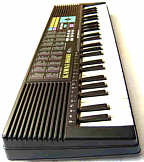 |
 |
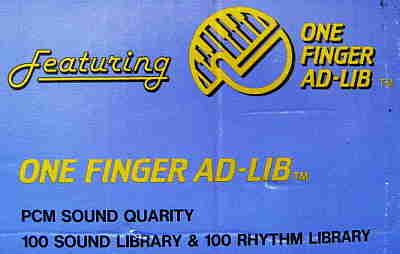
PCM SOUND QUARITY... |
 |
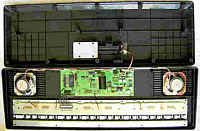 |

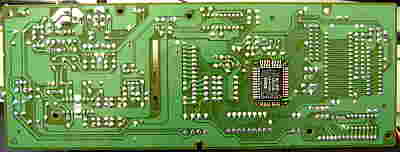 |
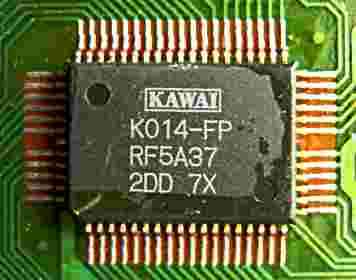 |
The preset sounds and their names strongly resemble Kawai MS20; they are are made from each 2 layered short looped medium resolution samples with independent envelopes. Most of these samples seem to be simply static natural waveforms, which makes them rather resemble simple 2 operator FM or analogue timbres; only few (e.g. saxophones) have an additional sampled attack phase. Some preset sounds contain chorus, tremolo or vibrato effects, and there are also some key split combinations. Very annoying is that all the preset sounds decay, i.e. even organ or flute tones grow silent like a piano, which makes them extremely unrealistic. Also the chorus subvoice in most sounds falls silent faster than the main voice (like a linear decay envelope), which sounds unrealistic. In the following I will only mention preset sounds those are special and properties those make them differ from what they are intended to be. (The annoying decay will not be particularly mentioned.)
Both "piano" sounds are made from static waveforms and thus resemble more like analogue piano timbres than a real one; "2" sounds a bit like made from filtered squarewave. "e. piano 1" is semi- metallic, "2" has additionally a rough chorus with glassy DAC aliasing noise, "3" sounds Hammond- like. "harpsi. 1" and "2" stop immediately after key release and resemble rather a clavinet. Both "ef piano" sounds contain slightly detuned chorus. "e. grand" is a synth piano with buzzy bass range and bright high notes. "bow. strings", "bow. cello", "bow. violin" have all a fast fluttering 7Hz tremolo. "pizzicato" is a picked string with percussive attack. "slow string", "slow cello", "slow violin" are like those "bow." sounds with slow attack phase. "tine strings" is a strings sound with fast tremolo layered with a fast decaying quiet glockenspiel in the bass range. "pizz strings" is a chorused string sound with percussive knocking attack. "br. strings" are between strings and a synth brass with fast tremolo. "sax 1" has a scratchy attack phase and could be also a cello. "brass pad" is a thin synth brass (like a french horn) with percussive attack. "fat brass 1" has detuned cold chorus and sounds a little squawky (a bit like Casio SA-series "brass ens", but less static); "2" is similar with duller reedy timbre and sounds very synthetic. "hard clavi" resembles a simple squarewave piano with buzzy bass range; "tine clavi" is similar with smacking attack and resembles a slap bass. "jazz organ" is a dull Hammond organ timbre; "tine organ" is the same with metallic percussive attack like a Rhodes piano. "drawbar 1" is a dull Hammond organ sound with mild chorus effect; "2" is brighter (resembles a metal pipe organ rank). "rock organ" is a thin and creaky organ timbre with a dose of chorus tremolo and dull bass range. "pipe organ" is a bright metal pipe organ rank with dull bass range. Both "accordion" sounds are a bit thin. "flex solo" is a plain triangular wave(?) piano with percussive attack, which reminds to historical videogames; mid and high notes resemble plain squarewave. "glass solo" sounds like a glass celesta. "strings/ flute" and "strings/ vibes" are split voices with "bow. string". "organ/ piano", "organ/ sax" and "a. bass/ organ" use the "jazz organ". "e. bass/ clavi" employs the "hard clavi".
"a. guitar" should be an acoustic one, but sounds too dull in the bass range and to dull and glassy with high notes. "e. guitar" is rather a bright slap bass with sampled attack phase that grunts way too slow in the bass range (but it makes a nice effect sound). "jazz guitar" is a brighter acoustic one. "distortion" resembles a a sitar with high notes, a chorused saxophone in the mid range and a funky e-bass in the bass range. "hawaiian" is another dull and glassy accoustic guitar. "a. bass" is a picked bass with sampled percussive attack that sounds way too dull with low notes. "e. bass 1" sounds a bit glassy (FM- like), while "2" is rather a semi- brassy synth bass with mild attack; both have no sustain. "funk bass" is a metallic slap bass with sampled attack and no sustain. "syn bass" sounds like "distortion" with additional bright and sitar- like chorus effect. "flute" is a dull metal flute with 6Hz tremolo and very soft and dull bass range. "recorder" has slow attack and resembles a wooden pipe organ rank; bass range. "clarinet 1" is bright and hollow; it grows duller during its forced decay; "2" is duller and resembles "recorder" transposed an octave down. "oboe" and "bassoon" have 6Hz tremolo. Also "piccolo" has that tremolo and semi- percussive attack; the bass range is dull. "tubular bell" has a hollow bass range. "orient bell" is bright with a dose of chorus; bass range is dull. "small bell" is bright and resembles a glockenspiel; the bass range more big glass bowls. "glass harp" is a bowed glass; the mid range is a little dull. "wine glass" is a bright clang with fast 8Hz vibrato, which sounds quite unrealistic ("orient bell" sounds rather like a glass); the bass range is dull and hollow. "cosmic" is a thin and bright synth bell with detuned cold fluttering chorus and creaky bass range. It has a nice My Music Center appeal although the timbre itself is different. "slow cosmic" is the same with slow attack (kind of synth strings). "music box" has a bit too soft attack; the mid range resembles a toy piano and the bass range is dull. "celesta" is a lower and even duller variant of it. "toy piano" resembles a bright picked string with percussive attack (like a small harp or banjo) and has nothing to do with the usual glockenspiel- like toy piano. "hard mallet" is a typical xylophone. "soft mallet" is duller with a bit longer sustain and resembles knocking on ceramic bowls; the bass range is dull. "steel drum" employs a strongly detuned chorus; the bass range is too dull. "glocken" is a glockenspiel, but it sounds thin and decays too fast; mid and low notes are too dull. "xylophone" resembles rather a dull harp. "gamelan" sounds rather like a large glockenspiel (metal xylophone; a real one should have a detuned subvoice?) and the bass range is dull. "vibes" is a vibraphone with a mild does of fast 8Hz tremolo; the dull bass range is semi- sonorous (realistic?). "sequence 1" is a short blipping harsh synth banjo with fast fluttering vibrato (this sound is also used for the button press noises); "2" is the same without vibrato. "drum set" is the keyboard drumkit mode. "banjo" sounds not thin and hollow enough and rather resembles a muted bright guitar; "koto" sounds more banjo- like and has some chorus.
All effect sounds unfortunately play the same note pitch on all keys, and when played polyphonic they all stay synched to the same algorithmic pitch envelope, which strongly limits their use. But at least they make nice phasing or zipper noise effects when more keys are pressed, which can be used for tekkno. Like all other preset sounds also these decay. "car" is a car horn. "invader" is an alternatingly high and low blipping pattern with a low popping or purring kind of zipper noise. "alarm" resembles a ringing classic phone bell while "telephone" is a digital phone ring sound (2 fast alternating tones). "gun" is a squarewave based historical videogame sound effect that goes "doenng!" in a buzzy way (like a POKEY shift register noise effect). "siren" is a harsh siren that pitch howls down with about 2Hz. "applause" is an applause sample (or frying eggs?) that decays within one second. (But for tekkno effect sounds a Casio SA-35 is more interesting.)
The "drum set" preset is a drum kit mode with 17 acoustic percussion + 2 synthetic sounds: {base, rimshot, low snare, low hand clap, high snare, cymbal, closed hihat, low tom, high hand clap, low conga, open hihat, mid tom, high conga, crash cymbal, high tom, metallic hihat, gong, low ufo, high ufo}, those repeat in the same order on higher keys (play 2x same sound for phasing). The gong is likely the down pitched "crash cymbal" sample. The "ufo" sound is a siren- like howling and fast pulsing sine wave(?) timbre that decays. Unlike Kawai MS720 the percussions don't sound dull but are quite bright, clear and impulsive sounding medium quality samples. Unlike Kawai MS720, the drumpads apparently are not user assignable, thus they always play {applause, snare drumroll, crash cymbal, toms drumroll}. "applause" corresponds to that preset sound, the "crash cymbal" to the cymbal from "drum set" mode. The 2nd pattern is a fast and louder fading snare roll. The 4th pattern consists of 4 high toms followed by 4 mid toms. The speed of these patterns depend on the selected rhythm tempo.
The accompaniment (started with "auto" button) has unfortunately only single finger chord mode and thus only accepts a few standard chords. The accompaniment styles are complex orchestrated and always use an individual intro and ending. There is no manual chord mode without rhythm, and a very annoying design flaw always stops the rhythm (plays its ending pattern) when any of the buttons 'rhythm', 'auto',' one finger ad-lib' are pressed to switch between rhythm only, rhythm + accompaniment and rhythm + accompaniment + "one finger ad-lib".
When the "one finger ad-lib" button is pressed, the rhythm with accompaniment starts and keys in the middle keyboard section play each a looped music pattern. The music style depends on the selected rhythm. The one finger ad-lib pattern plays always in the key of the current accompaniment chord. Each pattern starts as soon its key is pressed and stops as soon it is released. Unlike a groovebox it does not sync by itself to the rhythm, but this otherwise permits to trill the key in tricky ways for stutter effects; the patterns also can not be combined to play multiple of them simultaneously, but some are already polyphonic. So long you have not played any single finger chords by hand, the one finger ad-lib mode plays automatically a fixed preset chord sequence. Each pattern also plays in a default preset sound, that automatically assigns itself to the manual section (rightmost keyboard octave); this way you can quickly improvise to a given pattern and continue it using the same sound. But as soon you select any preset sound by hand, it overrides these default and uses from now on only the selected sound for the ad-lib patterns and the manual section.
The MS50 has the impressive count of 100 styles with each a set of 17 one finger ad-lib patterns; although some patterns are shared among styles, there are still plenty of interesting patterns available. There are no real tekkno accompaniments, but much nice synth pop stuff; "techno 1" and "2" instead resemble videogame synth pop of the C64 era with many nice squarewave blip and purr patterns. Some of these patterns employ very short blipping staccato notes those would be impossible to play by hand. To hear only the patterns and the main voice, you can mute rhythm and accompaniment with the accompaniment volume +/- buttons, but these buttons always play noises, mute also the drumpads, and you can not mute rhythm and accompaniment individually, which strongly limits the realtime usability of the instrument. But it is still a great source of inspiration and can be also well used as a sample source to permit more flexible post processing on a PC.
The demo is a complex orchestrated medley:
| removal of these screws voids warranty... | ||
 |
||
|
|